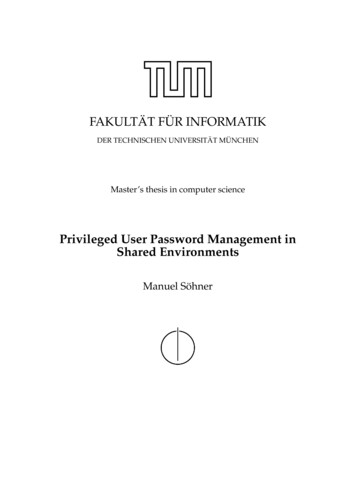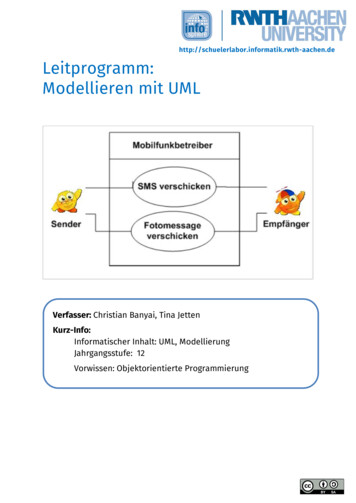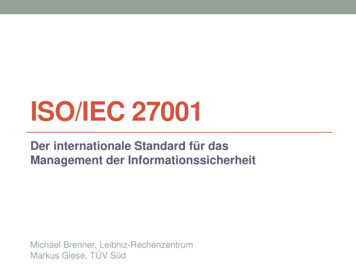
Transcription
FAKULTÄT FÜR INFORMATIKDER TECHNISCHEN UNIVERSITÄT MÜNCHENMaster’s thesis in computer sciencePrivileged User Password Management inShared EnvironmentsManuel Söhner
FAKULTÄT FÜR INFORMATIKDER TECHNISCHEN UNIVERSITÄT MÜNCHENMaster’s thesis in computer sciencePrivileged User Password Management in SharedEnvironmentsPrivileged User Password Management in uel SöhnerProf. Dr.-Ing. Georg CarleBenjamin Hof, M.ScDaniela Pöhn, Felix von Eye (LRZ)Dr.-Ing. Ingo Pansa (iC Consult GmbH)Submission date: April 15, 2014
I assure the single handed composition of this master’s thesis only supported by declaredresources.Munich, April 15, 2014Manuel Söhner
AcknowledgmentsI would like to thank the advisors Benjamin Hof from the Chair for Network Architecturesand Services, Daniela Pöhn and Felix von Eye from the Leibniz Supercomputing Centre,and Ingo Pansa from iC Consult for their good advice, support, and feedback during thewriting of this thesis.I would also like to thank Prof. Dr.-Ing. Georg Carle for supervising this thesis and for theadvice after the first presentation.vii
AbstractAdministrators often require access to privileged and shared accounts to manage systems,services, and applications. Subsequently, the unlimited power gives them unrestrictedaccess to sensitive data and to important components of the network infrastructure.In order to prevent from insider and outsider threats, the privileged user accounts needto be securely shared between authorized administrators and the access to these accountsneeds to be monitored and audited.This thesis analysis the threats that arise from privileged user accounts in shared environments and brings up countermeasures that need to be taken into account in a privilegeduser password management solution.Besides the security aspects, generic as well as specific requirements of two organizationsare presented. For that purpose, the status quo of the current password management aswell as use cases at the Leibniz Supercomputing Centre (LRZ) and iC Consult GmbH,which is a system integrator specialized in identity and access management, were analyzed.Based on that requirements catalog, three software products are evaluated and comparedto each other. Moreover, the suitability of these products for the purpose of the LRZ andiC Consult is examined.The thesis then proposes a generic architecture that addresses the management of privileged user passwords as well as the fine-grained control of access rights that administrators require to perform actions as privileged user. After that, a demonstrator illustratessome of the use cases that have been brought up during the requirements research by implementing the essential parts of the proposed architecture.In conclusion, the thesis shows that the management of privileged user passwords not onlyrequires a centralized component that securely controls which administrator is authorizedto access what privileged user passwords. Moreover, it is necessary to consider special usecases that normal password managers do not have to consider, for example, an emergencyaccess that allows administrators to use a privileged account which they usually are notauthorized to use. Additionally, the auditing of shared privileged accounts needs to beaddressed and the unrestricted access rights need to be taken into account.ix
Contents1234Introduction1.1 Problem Statement . . . . . . . . . . .1.2 Identity and Access Management . . .1.3 Definitions and Notation . . . . . . . .1.3.1 Terms and Definitions . . . . .1.3.2 Notation for XML Namespaces1.4 Approach and Structure of This Thesis.1123356Related Work2.1 eXtensible Access Control Markup Language . . . . . . . . . .2.2 Distributed Enforcement of XACML Policies With pam xacml2.3 Security Assertion Markup Language . . . . . . . . . . . . . .2.4 OpenID . . . . . . . . . . . . . . . . . . . . . . . . . . . . . . . .2.5 OAuth . . . . . . . . . . . . . . . . . . . . . . . . . . . . . . . .2.6 Shibboleth . . . . . . . . . . . . . . . . . . . . . . . . . . . . . .991516171819.Threat Model3.1 Basic Terms . . . . . . . . . . . . . . . . . . . . . . . . . . . . .3.2 Scenarios Concerning Privileged User Password Management3.3 Threat Targets, Threats and Attacks . . . . . . . . . . . . . . . .3.3.1 Hardware . . . . . . . . . . . . . . . . . . . . . . . . . .3.3.2 Network . . . . . . . . . . . . . . . . . . . . . . . . . . .3.3.3 Account . . . . . . . . . . . . . . . . . . . . . . . . . . .21212325262728Requirements4.1 Operational and Business Requirements . . . . . . . . . . . . . . . . .4.1.1 Security Regulations . . . . . . . . . . . . . . . . . . . . . . . .4.1.2 Information Distribution . . . . . . . . . . . . . . . . . . . . . .4.1.3 Separation of Duties . . . . . . . . . . . . . . . . . . . . . . . .4.1.4 Auditing and Reporting . . . . . . . . . . . . . . . . . . . . . .4.2 Practicability Requirements . . . . . . . . . . . . . . . . . . . . . . . .4.3 Non-Functional Requirements . . . . . . . . . . . . . . . . . . . . . . .4.3.1 Availability . . . . . . . . . . . . . . . . . . . . . . . . . . . . .4.3.2 Systems Integration . . . . . . . . . . . . . . . . . . . . . . . .4.3.3 Security . . . . . . . . . . . . . . . . . . . . . . . . . . . . . . .4.4 Use Cases and Requirements at the Leibniz Supercomputing Centre4.4.1 Infrastructure of the LRZ . . . . . . . . . . . . . . . . . . . . .4.4.2 Status Quo and Requirements . . . . . . . . . . . . . . . . . . .3333343536363637373838393939.xi
Contents4.54.65678xiiUse Cases and Requirements of iC Consult4.5.1 Infrastructure of iC Consult . . . . .4.5.2 Status Quo and Requirements . . . .Requirements Catalog . . . . . . . . . . . .Analysis of Established Solutions5.1 CA ControlMinder . . . . . . . . . . . . . . . . . . .5.1.1 System Architecture . . . . . . . . . . . . . .5.1.2 Test Environment . . . . . . . . . . . . . . . .5.1.3 Analysis Based on the Requirements Catalog5.2 Netwrix Privileged Account Manager . . . . . . . .5.2.1 System Architecture . . . . . . . . . . . . . .5.2.2 Test Environment . . . . . . . . . . . . . . . .5.2.3 Analysis Based on the Requirements Catalog5.3 Soffid Identity and Access Management . . . . . . .5.3.1 System Architecture . . . . . . . . . . . . . .5.3.2 Test Environment . . . . . . . . . . . . . . . .5.3.3 Analysis Based on the Requirements Catalog5.4 Summary of Software Analysis . . . . . . . . . . . .Architecture6.1 Components . . . . . . . . . . . . . . . . . . .6.1.1 Policy Administration Point . . . . . .6.1.2 Policy Decision Point . . . . . . . . . .6.1.3 Policy Enforcement Point . . . . . . .6.1.4 Password Manager . . . . . . . . . . .6.1.5 Audit Logging System . . . . . . . . .6.2 Security Considerations . . . . . . . . . . . .6.2.1 Encryption of Credentials . . . . . . .6.2.2 Secure Audit Logs . . . . . . . . . . .6.3 Analysis Based on the Requirements Catalog6.4 Summary . . . . . . . . . . . . . . . . . . . . .Specification and Implementation of a Demonstrator7.1 Authorization for PAM-Enabled Applications . . .7.2 Policy Decision Point . . . . . . . . . . . . . . . . .7.3 Jump Server . . . . . . . . . . . . . . . . . . . . . .7.4 Web Interface and Password Database . . . . . . 6777878798184.8991929394Evaluation8.1 iC Consult Compared to the Leibniz Supercomputing Centre .8.2 Applicability Analysis for the Leibniz Supercomputing Centre8.2.1 Applicability of the Architecture . . . . . . . . . . . . .8.2.2 Applicability of the Analyzed Software . . . . . . . . .8.3 Applicability Analysis for iC Consult . . . . . . . . . . . . . . .8.3.1 Applicability of the Architecture . . . . . . . . . . . . .95959797979898.
Contents8.3.29Applicability of the Analyzed Software . . . . . . . . . . . . . . . . .Conclusion and Future Work9.1 Summary . . . . . . . . . . . . . . . . . . . . . . . . . . . . . . . . . .9.2 Future Work . . . . . . . . . . . . . . . . . . . . . . . . . . . . . . . .9.2.1 Attribute-Based Encryption For Sensitive Data . . . . . . . .9.2.2 Transformation of High-Level Policies to Low-Level Policies9.2.3 Expansion to Other Operating Systems . . . . . . . . . . . .9.2.4 Virtual Environments . . . . . . . . . . . . . . . . . . . . . .Bibliography.98101101102103104104105107xiii
List of Figures3.1The Source of Greatest Risk to Sensitive Data . . . . . . . . . . . . . . . . . .224.1Organization Structure of the LRZ . . . . . . . . . . . . . . . . . . . . . . . .405.15.2495.35.45.5Screenshot of PuTTY Demonstrating Non-Repudiation in CA ControlMinderScreenshot of PuTTY Demonstrating Fine-Grained Access Control in CAControlMinder . . . . . . . . . . . . . . . . . . . . . . . . . . . . . . . . . . . .Netwrix Privileged Account Manager . . . . . . . . . . . . . . . . . . . . . .Architecture of Soffid Identity and Access Management . . . . . . . . . . . .Revealing a Password in the Soffid Self-Service Portal . . . . . . . . . . . . .505662636.16.26.3IETF Policy Framework Architecture . . . . . . . . . . . . . . . . . . . . . . .Jump Server . . . . . . . . . . . . . . . . . . . . . . . . . . . . . . . . . . . . .Full Architecture . . . . . . . . . . . . . . . . . . . . . . . . . . . . . . . . . .7075867.1Architecture of the Demonstrator . . . . . . . . . . . . . . . . . . . . . . . . .89xv
List of Tables2.12.2Attributes in the XACML Request Message . . . . . . . . . . . . . . . . . . .Attributes in the XACML Response Message . . . . . . . . . . . . . . . . . .10114.1Use Cases at iC Consult . . . . . . . . . . . . . . . . . . . . . . . . . . . . . .435.15.25.35.45.55.6Environment Specification for CA ControlMinder (Windows Server) .Environment Specification for CA ControlMinder (Linux Server) . . .Environment Specification for Windows Domain Controller . . . . . .Environment Specification for Netwrix Privileged Account Manager .Environment Specification for Soffid Identity and Access ManagementSummary of the Software Analysis Based on the Requirements Catalog.5151585864686.1Summary of the Architecture Based on the Requirements Catalog . . . . . .877.17.27.3Environment Specification for the Policy Decision Point . . . . . . . . . . . .Environment Specification for the Jump Server . . . . . . . . . . . . . . . . .Environment Specification for the Web Server . . . . . . . . . . . . . . . . . .9090918.1Requirements of the Leibniz Supercomputing Centre Compared to iC Consult 96.xvii
Listings2.12.22.3Example for a Separation of Duties in XACML . . . . . . . . . . . . . . . . .Excerpt of a Break-Glass Policy in XACML . . . . . . . . . . . . . . . . . . .Example for a Policy that Allows the Delegation of Rights . . . . . . . . . .1213147.17.27.37.47.5PAM Configuration for sudo . . . . . . . . . . . . . . . . .Example Request Message for sudo . . . . . . . . . . . . .Example Response Message That Permits the use of sudoProxyCommand in authorized keys File . . . . . . . . . .Command to Reach a Target System via the Jump Server9192939394.xix
1 IntroductionThe recent disclosure of global surveillance, which was uncovered by Edward Snowden,a former contractor of the U.S. National Security Agency (NSA), showed that the unrestricted access of administrators to sensitive data is a crucial aspect in computer networks.Often, privileged user accounts are shared between different administrators and therebythe abuse by an insider is hard to impute to a specific person. In order to reduce the security risk for an organization, the access to privileged user passwords needs to be controlledand the privileged access rights need to be managed.This chapter gives an overview on the problem that is addressed by this thesis and classifies the privileged user password management into the context of identity and accessmanagement.1.1 Problem StatementMany organizations employ at least one administrator that manages the IT infrastructurewith its corresponding business-critical resources. In order to do their job, the administrators are equipped with rights that give them access to operating systems, applications,databases and other data storage. Because of that, they are privileged users which have extensive authority on each system they administrate – and often beyond that. In some cases,those privileged users do not operate with personal accounts but share dedicated superuser accounts. This raises a problem in the area of accountability, since actions cannot beattributed to a specific person once a granted permission got abused [9]. Furthermore, theuser accounts with elevated access rights present a target for external as well as internalattackers and therefore provoke a high security risk.Moreover, privileged user accounts are also included in many network devices and software products that are shipped with a default username and password combination. Sometimes, the credentials are not changed by the IT administrators, which makes it easier forattackers to break into a system and manipulate or steal sensitive data [73].Besides the employees that use privileged identities, there are also applications and services that run under privileged user accounts, which therefore represent a security risk aswell [15]. Once a central component (e.g., a directory service or database) is compromised,it is easy to sabotage other network components or steal identities and data.The problem becomes more complicated in distributed environments, like it is the casewith outsourced departments. Here, different stakeholders are connected in a heteroge-1
1 Introductionneous environment and need to have access to the systems and data. Another example isthe growing sector of cloud computing, where administrators of a service provider haveaccess to the hardware they are managing in order to provide the infrastructure. Thosecould also gain access to the sensitive data or manipulate the system.For that reason, the system administrators need to establish a solution that protects thedata and restricts the access of privileged user accounts, based on the identity’s authorization level. In addition, an organization might also have an interest in reducing the accessof their administrators to a minimum in order to lower the possibility of getting attackedfrom inside the company.In order to solve the above mentioned problems, the organization needs to introduce adedicated security architecture that takes care of the authentication and authorization ofusers and applications. For that purpose, the organization has to manage all stakeholdersas identities and define the access permissions and policies that guard the data. Basisfor that are the business processes inside the institution, as they define the resources astakeholder requires to accomplish a task. That is where another problem could arise sincethe processes have to be analyzed and sometimes changed in order to extend the existinginfrastructure.1.2 Identity and Access ManagementIn most organizations people work with different kinds of sensitive data while fulfillingtheir tasks. In order to control which person has access to which data, the IT administratorsneed to provide a system that enforces access control policies. In most of the cases thesepolicies are derived from the business processes inside the organization. The essentialgoal is to give each person the minimum amount of access in order to secure the dataand protect from faults and malicious actions. In computer science, this idea is generallyreferred to as the principle of least privilege [64]. The simplest approach of achieving that goalis to give each person an individual and thus unique identity (e.g., a personal account) thatrepresents it on every system in the infrastructure.In order to authenticate a user and authorize the resource access, the systems utilize thepredefined information that is part of the individual identity. Controlling all that information is the purpose of the Identity Management (IdM). Besides creating, deleting, andmodifying the identities throughout their existence as part of the identity lifecycle management, the identities need to be monitored. For that purpose, the IdM software oftenprovides a logging component that fulfills the auditing requirements of the organization.Controlling the identities becomes even more important when external users can accessinternal systems or when users have access to external systems. For that purpose, the approach of a Federated Identity Management (FIdM) has been established, where autonomoussecurity domains are interconnected and share identities with uniform standards [6].On the other hand, there is the data that needs to be protected. This can be done by defining roles, access permissions, and policies that determine the necessary rights an identity2
1.3 Definitions and Notationhas to have in order to get access to a resource or object. This task is part of the accessmanagement and complements the identity management. The most important aspect ofthe access management is to apply the principle of least privilege to reduce the risk of people accessing sensitive data they should not have access to. Hence, these tasks are oftencombined to the term Identity and Access Management (IAM).A subarea of IAM is the Privileged Identity Management (PIM), which mostly deals withnon-personal accounts that are used by humans and software. As mentioned in chapter1.1, users with privileged accounts are a security risk and can cause a huge damage tothe organization. This is because privileged accounts have access to sensitive data andare able to change the configuration of hardware and software, most of the time withoutbeing tracked. Thus, these identities have to be managed and monitored accurately. Forthat purpose, the organization firstly defines who is allowed to perform specific actions.Then, the PIM has to monitor each identity and log the actions that have been performed ina session. Furthermore, a partial aspect of that is the Privileged User Password Management(PUPM) and the Shared Account Password Management (SAPM) [40].1.3 Definitions and NotationThis section introduces basic definitions and XML notations that are used throughout theremainder of this thesis.1.3.1 Terms and DefinitionsThe following terms are defined for the context of this thesis and are based on the suggestions of RFC 4949 [28].Attributes provide information that identify a person or system entity. Before the systemcan utilize them, for example, for the authorization process, an authority needs to predefine and assign the attributes to the identities.An identity represents and describes a person or other entity (e.g., a service or application)inside a system with various attributes. These attributes mainly focus on the personal datathat make an identity unique.A (system) user is defined as a person that uses and accesses resources that are providedby the system. In addition, also services and applications are referred to as “user”, sinceapplication-to-application scenarios are almost equal to the
5.4 Environment Specification for Netwrix Privileged Account Manager. . . .58 5.5 Environment Specification for Soffid Identity and Access Management. . .64 5.6 Summary of the S











